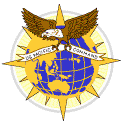Note: In April 2002, the Defense Department announced changes to its Unified Command Plan, creating a new Northern Command and shifting geographic areas of responsibility of several other commands. See the DoD announcement here.
United States Pacific Command USPACOM
The US Pacific Command [USPACOM] was established as a unified command on 01
January 1947 as an outgrowth of the command structure used during World
War II. The command is the oldest and largest of the United States'
nine unified commands. In October 1957, the US Pacific Command headquarters was moved from
Makalapa to Camp H.M. Smith, location of the headquarters of the
Commander, Marine Forces Pacific.
Added responsibilities were assigned to USCINCPAC on 01 January 1972 for military forces and elements in the Indian Ocean, Southern Asia and the Arctic. His area of responsibility was further expanded on 1 May 1976 to the east coast of Africa. This enlarged the U.S. Pacific
Command to more than 50 percent of the earth's surface, an area of over 100 million square miles. Another enlargement of the USPACOM area took place in October 1983, when USCINCPAC was assigned responsibility for the People's Republic of China, the Democratic People's Republic of Korea, the Mongolian People's Republic, and the Democratic Republic of Madagascar. The most recent enlargement of the USPACOM area of responsibility occurred on 7 July 1989, when the Alaskan Command (which had been disestablished in 1975) was reestablished at Elmendorf Air Force Base, Alaska as a subordinate unified command of USCINCPAC. The Unified Command Plans of 1989 and 1996 slightly reduced USCINCPAC's area of responsibility. In 1989, with the focus of attention shifting to the Middle East, the 16 August plan reassigned responsibility for
the Gulf of Oman and the Gulf of Aden to USCINCCENT. Likewise, the 01 January 1996 plan transferred the Seychelles and adjacent waters to USCINCCENT.
USPACOM Headquarters staff consists of about 530 Army, Navy, Air Force and Marine Corps officers and enlisted personnel, plus about 110 civil service employees. About 1,500 people belong to additional support units, such as the Asia-Pacific Center for Security Studies, the Information Systems Support Activity, the Pacific Automated Server Site Japan, the Pacific Stars and Stripes, the Joint Interagency Task Force West, the Joint Task Force Full-Accounting.
the Cruise Missile Support Activity, the Special Intelligence Communications, the Joint Intelligence Training Activity Pacific, and the Joint Intelligence Center Pacific.
Subordinate Units
Intelligence Directorate
US Army Pacific
US Pacific Fleet
Marine Forces Pacific
US Pacific Air Forces
US Forces Japan (Yokota AB)
US Forces Korea (Seoul)
Special Operations Command Pacific (Camp H.M. Smith, Hawaii)
Alaskan Command (Elmendorf AFB)
Sources
http://www.fas.org/irp/agency/dod/uspacom/
Created by John Pike
Maintained by Steven Aftergood
Updated Tuesday, November 11, 1997 7:52:38 PM





